Let's start off with saying, I'm a lazy person. My goal in life is getting what I want through the least amount of effort. In this tutorial on nutrient mixing, I'm going to teach you how to make one accurate batch, so you never have to again. Who the hell wants to measure large amounts of water?
One thing everyone should know about mixing nutrients, is that you always add your nutrients to 80-90% of the water you need, and then top up to the final volume once you've added them. This matters if you're making your own concentrates from salts and water, and it's a good practice to carry forward for accurate numbers. The reason for this, is because salt content is measured in mg/L, and/or a percentage of total volume. If you take 1L of water, and add 210.5g of Calcium nitrate, you end up with a final volume that is greater than 1L, as the salts increase the volume. That's now inaccurate. Instead, you add the calcium nitrate to 800 mL of water, and then once fully dissolved, you add water until you reach 1L. This is in fact a real recipe for making calcium nitrate concentrate. This is useful, because a 20kg bag is like $25, and makes 95L of concentrate. It contains 4% Calcium, and 3.3% nitrate nitrogen.
So now that we have the mixing concept down, how do we be lazy. OK, so you read on the bottle that the manufacturer says mix 10mL/gal Micro, 10mL/gal grow, and 5mL/gal bloom. Then everyone goes, "The manufacturers are just trying to push nutes, so mix half strength". So now, you're trying to do math, trying to get a desired EC, by changing all the mL/L amounts. If this is your life, you are doing it wrong, or at least the hardest way possible.
So what you do, is make a 2.5 gal batch at full strength. 1 quart is hard to be accurate. I use a 5 gallon mixing pail, which is actually pretty easy to get.
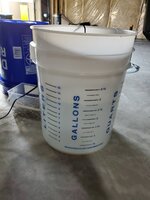
Cool, now you have your pail. Fill it to 2 gal with RO water, add in 25 mL of micro, 25 mL grow, and 12.5 mL bloom. Stir between each addition. Now, add more RO water until you reach 2.5 gal. You did it, a properly mixed batch of nutrients. Measure the EC, and write it down. Remember this is full strength. So what you do, is pour this into a spare pail. If you want 50%, measure 2 gal of full strength, and add it to a spare 5 gal pail. Measure out 2 gal of RO, and add it to the same pail. There you have it, 4 gal of 50% ready for your bucket. Measure EC and write it down. Add pH up or down to get it in the sweet spot, and you're done. Wasn't that infinitely easier than trying to divide small quantities of sometimes half a dozen base and additive amounts? Personally, I suggest litres and quarts, because 60% is 6 L or 6 qt. to 4 L or 4 qt. of RO water. Gallons adds a lot of conversion factors, which is a pain in my opinion.
Now your like, "That is great and all, but I need 25 gal. I'm not going to do this 10 times." Well, remember when you recorded the EC of the full-strength mix? The reason you did that is because you use it to mix large amounts. If you have a tank that holds 25 gal or so, fill it to 20 gal. Go grab your measuring pail, and this time you're going to make a concentrate. So, you start with 2.5 gal. You're making 25 gal, So you need to add 5 gallons at 50%. Since you want half strength, you mix up 2.5 gal at full strength x 5. This time, since you want 5 times as much nutrients, you mix at 5 times the strength.
Simple math. 25gal / 5 gallons of concentrate = 5X mixing strength. 50% strength is 2.5 gallons at 5X strength.
Add 125mL of Micro, 125mL of grow, 62.5mL of bloom to 2.5 gal of RO water. Take this, and add it to the approx. 20 gal sitting in your reservoir. Mix it in until EC is consistent. Keep adding RO and mixing until the EC reads the 50% EC value you wrote down earlier from the test batch. pH the solution, and you have 25 gal.
Now keep in mind, that final volumes are always irrelevant. What is relevant, is that the nutrients are kept in proper ratios, and that the concentration is correct. So, if it's all the same, why not just fill a bucket to 2 gal, and create a 10X strength solution. A good tip here, is that this will only work, if the elements in all the fertilizers you're adding, are common to them. For example, you can't add Potassium silicate to a 10 times concentration. You need to make 10X concentration by itself. I wouldn't suggest doing this with anything that contains carbonates, like many cal-mag supplements do. Also, AN pH perfect would be a bad idea to mix A and B, as buffers might react in higher concentrations. However, you can create handy 10X concentrates of each part.
I use a FloraNova bloom base at 2mL/L, potassium silicate at 1mL/L, and cali-magic at 1mL/L. I add silicon to benefit the plants, and I add the cali-magic, because the calcium and magnesium rebalance the additional potassium that comes with the silicon addition. Cali magic is great, because it has low nitrates, and doesn't use calcium carbonate, which would have an undesirable buffering effect. Pick additives wisely.
So anywho, I just add 200mL/L of FNB to the pail, fill to 10 L, mix, and transfer to a regular pail. Then I mix 100mL of KSi into 10L, and put in another pail. Same with the cali-magic. 3 pails, 10X concentrates. When I want to mix up say 100L of nutrients at around 70%, I fill to around 75L, add 7L from each pail, top up with RO water until desired EC is reached, pH it, and I'm done. This saves me ridiculous amounts of time, and keeps mistakes minimized.
As for my tools of the trade.
I use a bluelab EC pen. This is worth every penny. Converts to 500ppm and 700ppm scale, if you prefer large numbers. Just make sure to include the scale you are using, when talking about your EC values in the forum. Better yet, use EC only, and save the trouble
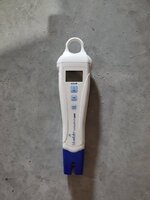
ph strips. Honestly, using a pH pen is pointless. Some people love those fancy digital readouts, but it's faster to dip a strip. No calibration or storage procedures, doesn't break, and they won't be instantly FUBAR'd if you put them in RO water. Well, unless you drop the whole reel into the water, lol. Where the digital makes sense, is when you want to start data plotting pH over time, or using automatic dosing. pH strips might not work if your colour blind, or have troubles differentiating shade changes.
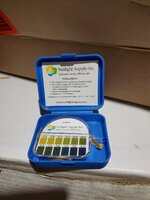
Measurement is important. Even more important, is that typically, unless you're using chemistry equipment, these things are somewhat inaccurate. It's important to use the same measuring glass or cup every time, so at least the inaccuracy will be shared by all your additives. Remember to rinse with RO water and dry with lint free towels between products. I use the syringe for small batch mixing, adding pH adjusters, and feeding seedlings. The little pipette, I use it to add pH adjusters in smaller reservoirs.
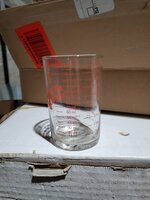
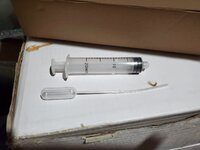
pH up and down. Basically, pH down is typically phosphoric acid. It is much safer to use than nitric and sulfuric acids, and it's tolerated well by plants, since they are less sensitive to P concentrations than N or S. Nitric acid can be good in veg, when plants want lots of nitrogen, but using it in flower will give you lower quality yields. Sulfuric acid can cause a excess if used too much, so it's not likely a good plan to use it. Keep in mind, this is acid, and safety glasses, gloves, and a way to rinse it off yourself is very important. If you get it on clothing, take them off. Remember your highschool chem training!
pH up, is typically potassium hydroxide. It's a strong base. Don't get it on yourself. Also, remember that if you're using large quantities to raise pH, this will change the K/Ca/Mg balance. That's why I add cali-magic to offset the potassium in KSi.
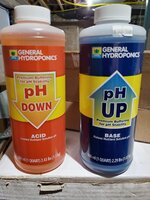
How to read a label. This is a label.
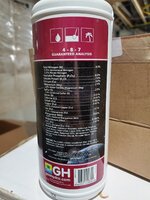
This is very important information that you should be using to calculate the ppm of each element in your solution. I prefer to do everything in litres, because it makes for much simpler calculations. For everything except P and K, you simply multiply the percent by 10, and it will give you the PPM for every 1mL you use to create a 1L solution.
N is 4%, so 1 mL in 1L final volume, is equal to 40 ppm. 2mL/L would be 80 ppm. At the overdose level they recommend of 3.75mL/L, it would be 150. The math doesn't change except for P and K. If you read the label, you'll see that the concentration is of phosphate (P2O5), not actual phosphorus. Instead of K it gives a percentage of soluble potash(K2O). The mother$&%&$rs. For P and K, you have to multiply the answer using the above math, by a conversion factor.
So to find out the amount of ppm of K or P, you have to find out the molar mass as a percentage of the total molar mass of the molecule that is on the label. Well, I will do this so you don't have to.
P has a molar mass of 30.974 g/mol
K has a molar mass of 39.098 g/mol
O has a molar mass of 15.999 g/mol
So one phosphate mol, has the mass of 2(30.974) + 5(15.999) = 141.898 g
So basically, we divide the mass of 2P(61.948 g) by 141.898 g = 0.437 (conversion factor)
So if there is 8% phosphate or 80 ppm for each mL/L, it's 80 x 0.437 = 35 ppm of P for every mL/L.
The math of K.
2(39.098) + 15.999 = 94.186 g / mol
78.196g / 94.186g = 0.830 (conversion factor)
7% is 70 g of potash. 70ppm of potash for 1mL/L x 0.830 = 58 ppm of K for every mL/L.
So 1mL/L of FNB (Floranova Bloom) will give you the following ppm levels
N 40
P 35
K 58
Ca 40
Mg 20
S 20
B 0.1
Cl 0.1
Co 0.02
Cu 0.1
Mn 0.3
Zn 0.1
Due to solubility limits, every fertilizer manufacturer will provide their products in different percentages of volume. This makes it very hard to compare different lines of nutrients, or even grow vs. bloom nutrients. The companies that make nutrients, they don't want you to do this. For one, it might make you realize how uneconomical their products are compared to others.
There is a way, which is to create a common value. I do this is by making K = 200ppm. For FNB you simply divide 200 by 58 to get a conversion factor of 3.45. For FNG you divide 200 by 83 to get 2.41. This is a apples to apples comparison of Floranova Bloom and Grow formulas.
Floranova Bloom 3.45mL/L Floranova Grow 2.41 mL/L
N 138 N 169
P 121 P 41
K 200 K 200
Ca 138 Ca 96
Mg 69 Mg 36
S 69 S 48
Now, fertilizers are less about concentration of elements, but rather their ratios. I read a fertilizer mix by seeing the ratios of Ca/K, Mg/K, N/K, P/K.
Ca/K FNB 69% FNG 48%
Mg/K 34% 18%
N/K 69% 84%
P/K 60% 21%
This illustrates the differences between veg and bloom formulas. I urge you to calculate your nutrient ppm levels as used and as corrected to 200ppm K, and see how they compare. You can also use their concentration and price to determine how economical they are. However, the main reason you calculate and add up all the ppm of every element, is because it's a great visual to see if you've created a horrible mix, where something is totally out of ratio. It's also a good way to come to the conclusion, that your mix is very weak, very strong, or very different in comparison to growers who are producing bumper crops.
Hope you found this information useful, if not horribly overwhelming and anxiety inducing. The funny thing is, this is way less complicated than soil science. The only reason the soil guys think they have the easy system, is because soil is very forgiving, but also very difficult to optimize. In hydro, it's easier to optimize, but won't forgive a person who just starts mixing all willy nilly. If you're new, start with a base nutrient, and be successful. Don't worry about calcium, as foliar feeding of the tap water you can't use for hydro because of too much calcium carbonate, will fix that right up.
Keep on toking.
One thing everyone should know about mixing nutrients, is that you always add your nutrients to 80-90% of the water you need, and then top up to the final volume once you've added them. This matters if you're making your own concentrates from salts and water, and it's a good practice to carry forward for accurate numbers. The reason for this, is because salt content is measured in mg/L, and/or a percentage of total volume. If you take 1L of water, and add 210.5g of Calcium nitrate, you end up with a final volume that is greater than 1L, as the salts increase the volume. That's now inaccurate. Instead, you add the calcium nitrate to 800 mL of water, and then once fully dissolved, you add water until you reach 1L. This is in fact a real recipe for making calcium nitrate concentrate. This is useful, because a 20kg bag is like $25, and makes 95L of concentrate. It contains 4% Calcium, and 3.3% nitrate nitrogen.
So now that we have the mixing concept down, how do we be lazy. OK, so you read on the bottle that the manufacturer says mix 10mL/gal Micro, 10mL/gal grow, and 5mL/gal bloom. Then everyone goes, "The manufacturers are just trying to push nutes, so mix half strength". So now, you're trying to do math, trying to get a desired EC, by changing all the mL/L amounts. If this is your life, you are doing it wrong, or at least the hardest way possible.
So what you do, is make a 2.5 gal batch at full strength. 1 quart is hard to be accurate. I use a 5 gallon mixing pail, which is actually pretty easy to get.

Cool, now you have your pail. Fill it to 2 gal with RO water, add in 25 mL of micro, 25 mL grow, and 12.5 mL bloom. Stir between each addition. Now, add more RO water until you reach 2.5 gal. You did it, a properly mixed batch of nutrients. Measure the EC, and write it down. Remember this is full strength. So what you do, is pour this into a spare pail. If you want 50%, measure 2 gal of full strength, and add it to a spare 5 gal pail. Measure out 2 gal of RO, and add it to the same pail. There you have it, 4 gal of 50% ready for your bucket. Measure EC and write it down. Add pH up or down to get it in the sweet spot, and you're done. Wasn't that infinitely easier than trying to divide small quantities of sometimes half a dozen base and additive amounts? Personally, I suggest litres and quarts, because 60% is 6 L or 6 qt. to 4 L or 4 qt. of RO water. Gallons adds a lot of conversion factors, which is a pain in my opinion.
Now your like, "That is great and all, but I need 25 gal. I'm not going to do this 10 times." Well, remember when you recorded the EC of the full-strength mix? The reason you did that is because you use it to mix large amounts. If you have a tank that holds 25 gal or so, fill it to 20 gal. Go grab your measuring pail, and this time you're going to make a concentrate. So, you start with 2.5 gal. You're making 25 gal, So you need to add 5 gallons at 50%. Since you want half strength, you mix up 2.5 gal at full strength x 5. This time, since you want 5 times as much nutrients, you mix at 5 times the strength.
Simple math. 25gal / 5 gallons of concentrate = 5X mixing strength. 50% strength is 2.5 gallons at 5X strength.
Add 125mL of Micro, 125mL of grow, 62.5mL of bloom to 2.5 gal of RO water. Take this, and add it to the approx. 20 gal sitting in your reservoir. Mix it in until EC is consistent. Keep adding RO and mixing until the EC reads the 50% EC value you wrote down earlier from the test batch. pH the solution, and you have 25 gal.
Now keep in mind, that final volumes are always irrelevant. What is relevant, is that the nutrients are kept in proper ratios, and that the concentration is correct. So, if it's all the same, why not just fill a bucket to 2 gal, and create a 10X strength solution. A good tip here, is that this will only work, if the elements in all the fertilizers you're adding, are common to them. For example, you can't add Potassium silicate to a 10 times concentration. You need to make 10X concentration by itself. I wouldn't suggest doing this with anything that contains carbonates, like many cal-mag supplements do. Also, AN pH perfect would be a bad idea to mix A and B, as buffers might react in higher concentrations. However, you can create handy 10X concentrates of each part.
I use a FloraNova bloom base at 2mL/L, potassium silicate at 1mL/L, and cali-magic at 1mL/L. I add silicon to benefit the plants, and I add the cali-magic, because the calcium and magnesium rebalance the additional potassium that comes with the silicon addition. Cali magic is great, because it has low nitrates, and doesn't use calcium carbonate, which would have an undesirable buffering effect. Pick additives wisely.
So anywho, I just add 200mL/L of FNB to the pail, fill to 10 L, mix, and transfer to a regular pail. Then I mix 100mL of KSi into 10L, and put in another pail. Same with the cali-magic. 3 pails, 10X concentrates. When I want to mix up say 100L of nutrients at around 70%, I fill to around 75L, add 7L from each pail, top up with RO water until desired EC is reached, pH it, and I'm done. This saves me ridiculous amounts of time, and keeps mistakes minimized.
As for my tools of the trade.
I use a bluelab EC pen. This is worth every penny. Converts to 500ppm and 700ppm scale, if you prefer large numbers. Just make sure to include the scale you are using, when talking about your EC values in the forum. Better yet, use EC only, and save the trouble

ph strips. Honestly, using a pH pen is pointless. Some people love those fancy digital readouts, but it's faster to dip a strip. No calibration or storage procedures, doesn't break, and they won't be instantly FUBAR'd if you put them in RO water. Well, unless you drop the whole reel into the water, lol. Where the digital makes sense, is when you want to start data plotting pH over time, or using automatic dosing. pH strips might not work if your colour blind, or have troubles differentiating shade changes.

Measurement is important. Even more important, is that typically, unless you're using chemistry equipment, these things are somewhat inaccurate. It's important to use the same measuring glass or cup every time, so at least the inaccuracy will be shared by all your additives. Remember to rinse with RO water and dry with lint free towels between products. I use the syringe for small batch mixing, adding pH adjusters, and feeding seedlings. The little pipette, I use it to add pH adjusters in smaller reservoirs.


pH up and down. Basically, pH down is typically phosphoric acid. It is much safer to use than nitric and sulfuric acids, and it's tolerated well by plants, since they are less sensitive to P concentrations than N or S. Nitric acid can be good in veg, when plants want lots of nitrogen, but using it in flower will give you lower quality yields. Sulfuric acid can cause a excess if used too much, so it's not likely a good plan to use it. Keep in mind, this is acid, and safety glasses, gloves, and a way to rinse it off yourself is very important. If you get it on clothing, take them off. Remember your highschool chem training!
pH up, is typically potassium hydroxide. It's a strong base. Don't get it on yourself. Also, remember that if you're using large quantities to raise pH, this will change the K/Ca/Mg balance. That's why I add cali-magic to offset the potassium in KSi.

How to read a label. This is a label.

This is very important information that you should be using to calculate the ppm of each element in your solution. I prefer to do everything in litres, because it makes for much simpler calculations. For everything except P and K, you simply multiply the percent by 10, and it will give you the PPM for every 1mL you use to create a 1L solution.
N is 4%, so 1 mL in 1L final volume, is equal to 40 ppm. 2mL/L would be 80 ppm. At the overdose level they recommend of 3.75mL/L, it would be 150. The math doesn't change except for P and K. If you read the label, you'll see that the concentration is of phosphate (P2O5), not actual phosphorus. Instead of K it gives a percentage of soluble potash(K2O). The mother$&%&$rs. For P and K, you have to multiply the answer using the above math, by a conversion factor.
So to find out the amount of ppm of K or P, you have to find out the molar mass as a percentage of the total molar mass of the molecule that is on the label. Well, I will do this so you don't have to.
P has a molar mass of 30.974 g/mol
K has a molar mass of 39.098 g/mol
O has a molar mass of 15.999 g/mol
So one phosphate mol, has the mass of 2(30.974) + 5(15.999) = 141.898 g
So basically, we divide the mass of 2P(61.948 g) by 141.898 g = 0.437 (conversion factor)
So if there is 8% phosphate or 80 ppm for each mL/L, it's 80 x 0.437 = 35 ppm of P for every mL/L.
The math of K.
2(39.098) + 15.999 = 94.186 g / mol
78.196g / 94.186g = 0.830 (conversion factor)
7% is 70 g of potash. 70ppm of potash for 1mL/L x 0.830 = 58 ppm of K for every mL/L.
So 1mL/L of FNB (Floranova Bloom) will give you the following ppm levels
N 40
P 35
K 58
Ca 40
Mg 20
S 20
B 0.1
Cl 0.1
Co 0.02
Cu 0.1
Mn 0.3
Zn 0.1
Due to solubility limits, every fertilizer manufacturer will provide their products in different percentages of volume. This makes it very hard to compare different lines of nutrients, or even grow vs. bloom nutrients. The companies that make nutrients, they don't want you to do this. For one, it might make you realize how uneconomical their products are compared to others.
There is a way, which is to create a common value. I do this is by making K = 200ppm. For FNB you simply divide 200 by 58 to get a conversion factor of 3.45. For FNG you divide 200 by 83 to get 2.41. This is a apples to apples comparison of Floranova Bloom and Grow formulas.
Floranova Bloom 3.45mL/L Floranova Grow 2.41 mL/L
N 138 N 169
P 121 P 41
K 200 K 200
Ca 138 Ca 96
Mg 69 Mg 36
S 69 S 48
Now, fertilizers are less about concentration of elements, but rather their ratios. I read a fertilizer mix by seeing the ratios of Ca/K, Mg/K, N/K, P/K.
Ca/K FNB 69% FNG 48%
Mg/K 34% 18%
N/K 69% 84%
P/K 60% 21%
This illustrates the differences between veg and bloom formulas. I urge you to calculate your nutrient ppm levels as used and as corrected to 200ppm K, and see how they compare. You can also use their concentration and price to determine how economical they are. However, the main reason you calculate and add up all the ppm of every element, is because it's a great visual to see if you've created a horrible mix, where something is totally out of ratio. It's also a good way to come to the conclusion, that your mix is very weak, very strong, or very different in comparison to growers who are producing bumper crops.
Hope you found this information useful, if not horribly overwhelming and anxiety inducing. The funny thing is, this is way less complicated than soil science. The only reason the soil guys think they have the easy system, is because soil is very forgiving, but also very difficult to optimize. In hydro, it's easier to optimize, but won't forgive a person who just starts mixing all willy nilly. If you're new, start with a base nutrient, and be successful. Don't worry about calcium, as foliar feeding of the tap water you can't use for hydro because of too much calcium carbonate, will fix that right up.
Keep on toking.


